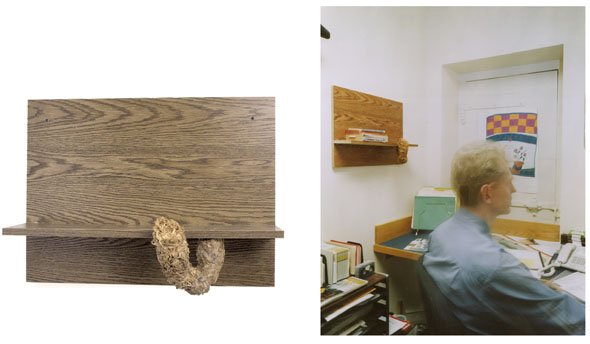Restless Shelves
ABOUT THE RESTLESS SHELVES PROJECT
In 2000, I began to make hybrid pieces that allowed for and depend upon a different kind of exchange with my audience. Restless Shelves—simultaneously furniture and sculpture—are conjunctive works in which a small carved sculpture is attached to the underside of a shelf. I fabricate most of the shelves, but occasionally, I have purchased ready-mades from stores such as Ikea, the populist purveyor of good, cheap design for all. I have invited people to select a shelf, install it at home or work, to “use” it, and to photograph it for me in situ.
My project is simultaneously private and interactive. Each Restless Shelf functions purely as a work of art in my studio, and is, as well, a mutable object in other environments. In the studio I indulgently cosset my ideas and carving skills into the often corporeal wooden objects that are affixed to the shelves. It preserves my solitude and authority in the studio, and at the same time, requires that I surrender my control to those who employ the shelves. In my collaborators’ domains, these restless shelves might invite play, serve as altars and stages, or be purely functional. This venture illustrates Marcel Duchamp’s premise in his essay “The Creative Act”, that a work of art is completed by the viewer.
I first read Primo Levi's short story "Psychophant" in The New Yorker in 1990. The psychophant is a device that produces uncanny portrait-objects. Ten years later, unconsciously inspired by his tale, I made my first uncanny object, a shelf-sculpture that, like his psychophant, invites interaction. I called mine a restless shelf. There are now 33 of these Restless Shelves. I produced a book that documents them as discrete works in my studio and then in situ in my collaborators' domains. I bought the rights to publish “Psychophant” from Simon and Schuster, and it is an integral part of this book. The book's form, tête-bêche (French for head-to-tail), is a manner of bookbinding in which two books share a spine but face opposite directions. As combining literature with visual art is yet another hybrid enterprise, it is with admiration and in the spirit of synchronicity that I join my work to his.






















